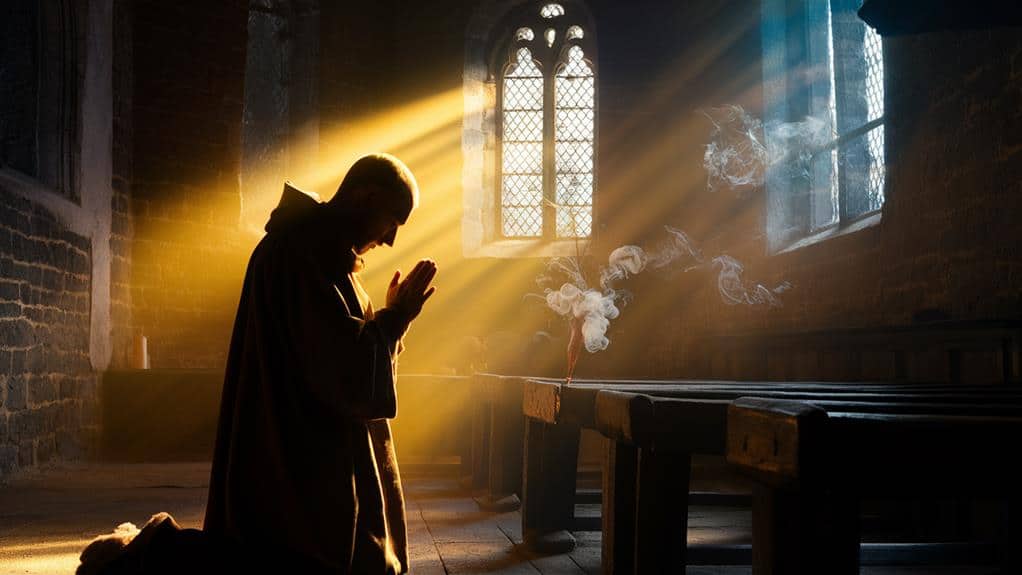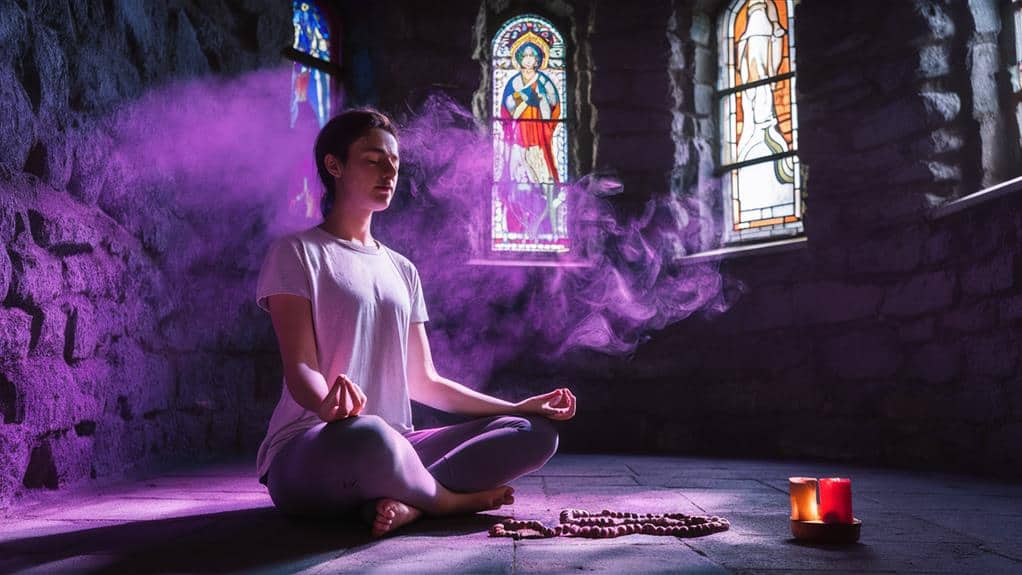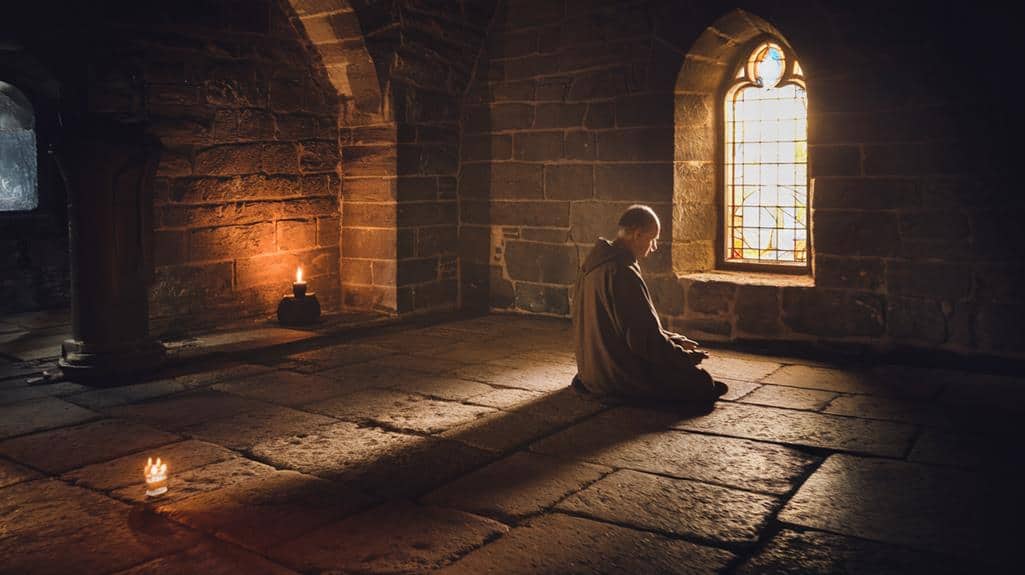Mysticism and the Practice of Centering Prayer
You’ll discover that mysticism and Centering Prayer share an intimate connection that transcends traditional religious boundaries. When you sit in silence, letting go of your thoughts and expectations, you’re participating in an ancient practice that mystics have embraced for centuries. As you journey deeper into contemplative prayer, you’ll encounter a profound stillness where the Divine presence becomes palpable—not through words or concepts, but through direct experience. Yet this is just the beginning of understanding how mysticism and Centering Prayer can transform your spiritual life and open doorways to sacred dimensions you never knew existed.
Origins of Centering Prayer

In the 1970s, three Trappist monks at St. Joseph’s Abbey in Spencer, Massachusetts, developed Centering Prayer as a response to growing spiritual hunger in the West.
You’ll find that these contemplatives – Thomas Keating, William Meninger, and Basil Pennington – drew deeply from Christianity’s contemplative heritage, particularly The Cloud of Unknowing, a 14th-century mystical text.
What you’re encountering in Centering Prayer isn’t entirely new – it’s a contemporary expression of ancient wisdom that’s been passed down through monasteries for centuries.
The method they’ve developed bridges Eastern and Western spiritual practices, though it’s firmly rooted in Christian contemplative tradition.
You’re inheriting a practice that emerged when these monks noticed young people turning to Eastern meditation techniques, seeking the depth they couldn’t find in conventional religious practice.
When you practice Centering Prayer, you’re participating in a tradition that’s both ancient and modern, one that’s been carefully crafted to help you access the contemplative dimension of your faith.
It’s a method that’s been stripped of complex theological language while maintaining its profound spiritual essence.
The Divine Within
Through Centering Prayer, you’re awakening to a profound reality – the Divine presence that exists within every human being. As you settle into silence, you’ll discover that this sacred essence isn’t something distant or separate from you, but rather an intimate presence woven into the very fabric of your being.
It’s here, in this sacred interior space, that you’ll encounter what mystics throughout the ages have described as the indwelling Spirit. When you release your thoughts and open yourself to this deeper dimension of reality, you’re not creating something new but rather becoming aware of what’s always been present.
You’re learning to recognize the subtle movements of grace that flow through your consciousness like a gentle stream. This Divine presence isn’t confined to churches or temples; it’s expressing itself through your everyday experiences, your relationships, and your deepest longings.
As you continue your practice, you’ll find that this inner sanctuary becomes increasingly accessible, transforming how you perceive yourself and your connection to the sacred. The boundaries between the human and divine begin to dissolve, revealing your true nature as a vessel of infinite love.
Beyond Thoughts and Words

Moving beyond the domain of thoughts and words, Centering Prayer invites you to experience a dimension of reality that transcends mental concepts.
As you settle into the practice, you’ll discover that true contemplation exists in the spaces between thoughts, in the vast silence that underlies all mental activity.
When you release your attachment to language and conceptual thinking, you’re entering a sphere where direct experience becomes your teacher.
You’ll find that what you’ve been seeking can’t be captured in words or contained within intellectual frameworks. This wordless knowing emerges naturally as you learn to rest in pure awareness, letting go of your need to analyze, categorize, or understand through conventional means.
The practice opens you to a way of knowing that’s both intimate and universal – a consciousness that doesn’t depend on verbal expression or rational thought.
You’re learning to trust in a deeper wisdom that operates beyond the constraints of language, where truth reveals itself not through words but through presence.
In this sacred space, you’ll discover that the most profound realities often communicate themselves in complete silence.
Daily Practice Essentials
While mystical experiences can arise spontaneously, establishing a consistent daily practice creates fertile ground for deeper contemplation.
You’ll want to set aside two periods of 20-30 minutes each day, ideally in the early morning and late afternoon, when you’re less likely to be disturbed. Choose a quiet, comfortable space where you can sit upright with dignity, whether on a chair or meditation cushion.
Begin by setting a gentle timer and choosing your sacred word – a simple, one or two-syllable word that expresses your intention to consent to God’s presence. As thoughts arise, don’t fight them or analyze them; simply return to your sacred word with gentleness.
You’ll find that this practice isn’t about achieving a particular state or having special experiences, but rather about developing receptivity to the Divine. Notice how you’re gradually learning to rest in the space beyond concepts and images.
Remember that contemplative practice isn’t measured by feelings of success or failure. Instead, it’s your faithful return to silence, day after day, that deepens your capacity for presence and transforms your relationship with the ineffable.
Deepening Your Contemplative Experience

After establishing a regular centering prayer practice, you’ll naturally begin to notice subtle shifts in your contemplative experience. As your awareness deepens, you’ll find yourself settling into silence more readily, discovering layers of consciousness beyond your usual mental chatter. You’ll start recognizing the difference between surface thoughts and the deeper currents of spiritual awareness that flow beneath them.
To deepen your practice further, you’ll need to embrace what contemplatives call the “dark night” – those moments when familiar spiritual consolations fall away, leaving you in apparent emptiness. Don’t resist these periods; they’re essential gateways to profound transformation. Let your practice evolve naturally, releasing expectations about what you should feel or experience.
You’ll discover that true contemplation isn’t about achieving particular states but about consenting to divine presence in whatever form it takes.
Pay attention to how your practice extends beyond formal sitting times. You may notice increased sensitivity to sacred moments in daily life, a natural turning toward silence, and a growing capacity to rest in uncertainty.
These are signs that your contemplative journey is maturing, gradually reshaping your entire way of being.









